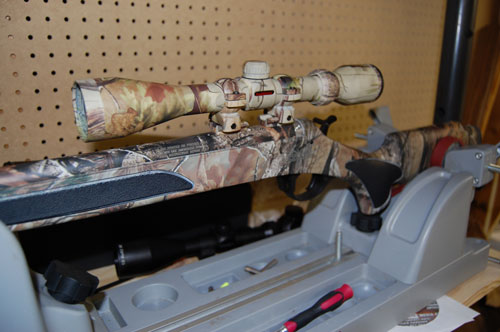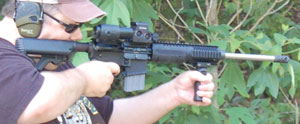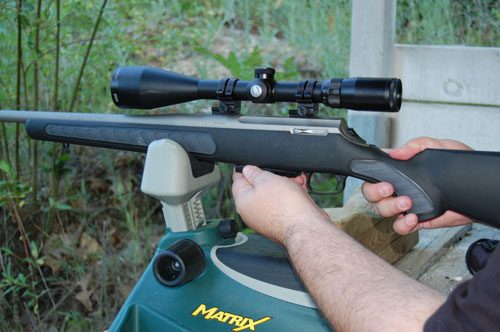 You can walk into any sporting goods store or gun shop and start up a serious conversation with a simple question: “What’s the best rifle for deer?”
You can walk into any sporting goods store or gun shop and start up a serious conversation with a simple question: “What’s the best rifle for deer?”
The flat truth of the matter is, there is no one “perfect” deer rifle. There are, in fact, many. There is no best and there is no worst, although I do have my favorites and a few I consider dogs. But there are some common misconceptions out there that we need to clear up.
#1 (and I hate this one): The .30-30 is the best brush gun because the rounded bullet can slam through brush and not deflect your shot.
If I had a nickel for every time I heard this as a Michigan deer hunter, I’d have enough money to buy a really nice .30-30.
It does not matter what you’re shooting — anything that gets between you and the target can and will alter the course of the bullet. I don’t care if you’re shooting a .375 H&H or even a .50 BMG. Shoot it through some thick brush and that bullet isn’t going to the bull’s-eye. Not only that, but if you have brush in your way, you shouldn’t be taking the shot anyway. Wait for the good shot.
The real reason a .30-30 makes a good brush gun is quite simple. If you’re hunting in thick cover, the short length of most .30-30 rifles makes them handle well and allow you to get the gun to your shoulder quickly when you do get that good, open shot.
#2: X caliber is too big/small for deer.
A recent trip to a large retailer showed me why some people shouldn’t be giving advice from behind the gun counter. The guy was telling a customer that a .243 was just too small to take a whitetail. Nope, he needed to buy a .270 at least. “Just like this one here we have one sale right now…”
In the hands of anyone who has done the proper amount of shooting with a rifle, any legal rifle will work for whitetail deer. There are variables to take into account, of course. Range is one. Ammo cost might be one depending on what you’re shooting and your budget. A .223 is on the small end, but in the right hands it can be a lethal deer round. On the flip side, a .375 H&H can be a very effective deer round, but it’s not for everyone.
Get out and shoot as much as you can. And be sure to check the regulations for the state you’re hunting. Know the rules and follow them.
Do you want my opinion as to what is the best caliber for deer? Well, that’s up to you. I have killed more deer and other big game with a Winchester Model 70 in 7mm Rem Mag than I have with any other caliber. That’s not to say it is always the gun I reach for, but more often than not, it is. I just know what that gun is going to do. I know because I have shot it over and over again at the range.
I’ll also throw in the disclaimer here that while yes, nearly any rifle can be a good deer rifle, there certainly are better rifles for some situations. Because of that fact, I need to have quite a few in the safe. If my wife reads this, I NEED those guns!
#3: I got it bore-sighted when I bought it, that ought to be good enough.
 No, it isn’t close enough for hunting. Bore-sighting just means the scope and the rifle are basically aligned. You still need to put in the time shooting it at the range to get it zeroed in. Ethical hunters, and I’m sure you are one, make sure they know where the bullet goes. Take the time and practice.
No, it isn’t close enough for hunting. Bore-sighting just means the scope and the rifle are basically aligned. You still need to put in the time shooting it at the range to get it zeroed in. Ethical hunters, and I’m sure you are one, make sure they know where the bullet goes. Take the time and practice.
I used to work the gun counter of a sporting goods store. Without fail, the day before firearm deer season would open, some yahoo would come in and want to buy a gun for hunting. I started asking where the guy was going to be hunting so I could be sure to be very far away from him the next morning.
#4: I need to spend a lot of money to buy a good rifle.
No, you don’t. There are some truly great budget rifles on the market, and more are produced every day.
What makes a good deer gun?
There are so many good guns out there. In fact, there really aren’t many bad ones, but there are a few that are exceptionally good.
Let’s talk about the standard of accuracy. Minute of angle (MOA) refers to the spread between bullets for a three-shot group at 100 yards. If a gun is a MOA gun, it can produce a three-shot group with a 1-inch spread between the shots. Sub-MOA, means that the three shots will be within an inch at that range.
There are some great rifles that are sub-MOA and won’t bust your budget. Examples are the Thompson/Center Venture and the Weatherby Vanguard/Howa 1500. All of these guns offer great accuracy, great triggers and prices in the $500 range.
Before you set your sights on a gun, do yourself a favor and check the ballistics of the round you intend to go for. A ballistics chart will tell you the basic information of what the bullet will do after it leaves the muzzle. Have a good idea of how much the bullet will drop at a given yardage and what type of energy the bullet will still have at a given yardage. That, along with proper range time, will give you the confidence to make the right shot and harvest the deer.
The same goes for a slug gun and even a muzzleloader. There are some flat-out amazing muzzleloaders and slug guns out there. Some areas require the use of a slug gun or a muzzleloader due to large population densities. The truth is that some of the modern sluggers are so good, it is kind of like cheating. I won’t tell if you won’t.
The Trigger Revolution
 Some of the newest trends in rifles have really helped the hunter. One area is in the trigger systems. I used to think a trigger was simple and that it didn’t matter as much. Then I got educated by a couple of guys on how a good trigger can make the shot. I had a rifle that shot okay, but not great. It turned out that the excessive trigger pull was causing me to pull the shot ever so slightly. A few adjustments and the rifle was much improved.
Some of the newest trends in rifles have really helped the hunter. One area is in the trigger systems. I used to think a trigger was simple and that it didn’t matter as much. Then I got educated by a couple of guys on how a good trigger can make the shot. I had a rifle that shot okay, but not great. It turned out that the excessive trigger pull was causing me to pull the shot ever so slightly. A few adjustments and the rifle was much improved.
Today, many of the things gun manufacturers are doing to make guns better involves the trigger system. This all started with the introduction of the Savage AccuTrigger in 2003. The Savage Model 12 Varmint was the first rifle to feature the system, followed shortly by most of Savage’s big-game hunting rifles at the time. It is now also in most of their rimfire guns too, said Bill Dermody, marketing director for Savage Arms.
“The AccuTrigger is what put Savage on the map,” he said. “I can safely say that we would not be anywhere near where we are today without it.”
The AccuTrigger spawned a revolution in trigger systems throughout the industry.
“They say imitation is the sincerest form of flattery,” Demody said. “I guess that makes us the most flattered gun company around.”
Similar systems are now available from Marlin and Mossberg. And every major manufacturer has updated their trigger system in the past few years.
An old friend of mine used to say there was just something about a really good trigger that made all the difference. He was right.






